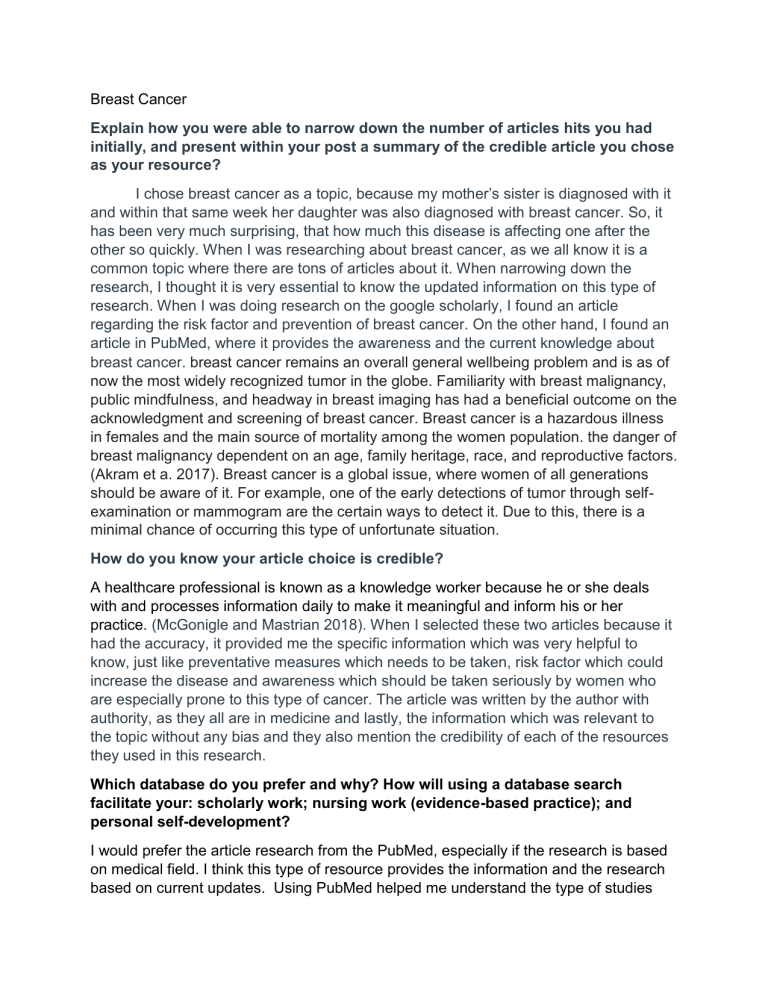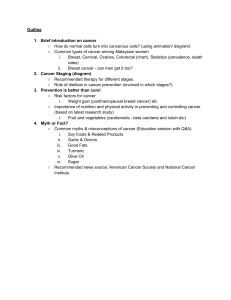
Breast Cancer Explain how you were able to narrow down the number of articles hits you had initially, and present within your post a summary of the credible article you chose as your resource? I chose breast cancer as a topic, because my mother’s sister is diagnosed with it and within that same week her daughter was also diagnosed with breast cancer. So, it has been very much surprising, that how much this disease is affecting one after the other so quickly. When I was researching about breast cancer, as we all know it is a common topic where there are tons of articles about it. When narrowing down the research, I thought it is very essential to know the updated information on this type of research. When I was doing research on the google scholarly, I found an article regarding the risk factor and prevention of breast cancer. On the other hand, I found an article in PubMed, where it provides the awareness and the current knowledge about breast cancer. breast cancer remains an overall general wellbeing problem and is as of now the most widely recognized tumor in the globe. Familiarity with breast malignancy, public mindfulness, and headway in breast imaging has had a beneficial outcome on the acknowledgment and screening of breast cancer. Breast cancer is a hazardous illness in females and the main source of mortality among the women population. the danger of breast malignancy dependent on an age, family heritage, race, and reproductive factors. (Akram et a. 2017). Breast cancer is a global issue, where women of all generations should be aware of it. For example, one of the early detections of tumor through selfexamination or mammogram are the certain ways to detect it. Due to this, there is a minimal chance of occurring this type of unfortunate situation. How do you know your article choice is credible? A healthcare professional is known as a knowledge worker because he or she deals with and processes information daily to make it meaningful and inform his or her practice. (McGonigle and Mastrian 2018). When I selected these two articles because it had the accuracy, it provided me the specific information which was very helpful to know, just like preventative measures which needs to be taken, risk factor which could increase the disease and awareness which should be taken seriously by women who are especially prone to this type of cancer. The article was written by the author with authority, as they all are in medicine and lastly, the information which was relevant to the topic without any bias and they also mention the credibility of each of the resources they used in this research. Which database do you prefer and why? How will using a database search facilitate your: scholarly work; nursing work (evidence-based practice); and personal self-development? I would prefer the article research from the PubMed, especially if the research is based on medical field. I think this type of resource provides the information and the research based on current updates. Using PubMed helped me understand the type of studies and test which is used regarding the research. In nursing school, it is very much a helpful resource because it provides the accurate information which a student needs to know in his or her research.it shows an evidence base information which is used on this type of research. I have never used PubMed as a research tool, it was my first time. It really made me think, this type source would help me increase the knowledge not only for myself but also, I can share it to others. Akram, M., Iqbal, M., Daniyal, M., & Khan, A. U. (2017). Awareness and current knowledge of breast cancer. Biological research, 50(1), 33. https://doi.org/10.1186/s40659-017-0140-9 McGonigle, D. & Mastrian, K. (2018). Nursing informatics and the foundation of knowledge (4th ed.). Burlington, MA: Jones and Bartlett. Sun, Y. S., Zhao, Z., Yang, Z. N., Xu, F., Lu, H. J., Zhu, Z. Y., Shi, W., Jiang, J., Yao, P. P., & Zhu, H. P. (2017). Risk Factors and Preventions of Breast Cancer. International journal of biological sciences, 13(11), 1387–1397. https://doi.org/10.7150/ijbs.21635



